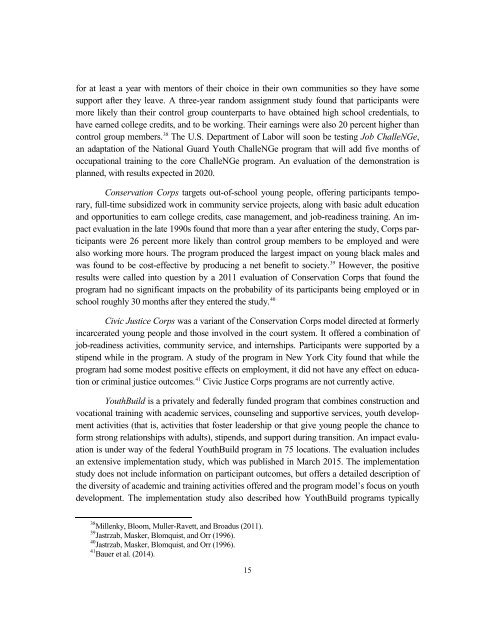Opportunity Youth: Disenfranchised Young People
Opportunity Youth: Disenfranchised Young People
Opportunity Youth: Disenfranchised Young People
Create successful ePaper yourself
Turn your PDF publications into a flip-book with our unique Google optimized e-Paper software.
for at least a year with mentors of their choice in their own communities so they have some<br />
support after they leave. A three-year random assignment study found that participants were<br />
more likely than their control group counterparts to have obtained high school credentials, to<br />
have earned college credits, and to be working. Their earnings were also 20 percent higher than<br />
control group members. 38 The U.S. Department of Labor will soon be testing Job ChalleNGe,<br />
an adaptation of the National Guard <strong>Youth</strong> ChalleNGe program that will add five months of<br />
occupational training to the core ChalleNGe program. An evaluation of the demonstration is<br />
planned, with results expected in 2020.<br />
Conservation Corps targets out-of-school young people, offering participants temporary,<br />
full-time subsidized work in community service projects, along with basic adult education<br />
and opportunities to earn college credits, case management, and job-readiness training. An impact<br />
evaluation in the late 1990s found that more than a year after entering the study, Corps participants<br />
were 26 percent more likely than control group members to be employed and were<br />
also working more hours. The program produced the largest impact on young black males and<br />
was found to be cost-effective by producing a net benefit to society. 39 However, the positive<br />
results were called into question by a 2011 evaluation of Conservation Corps that found the<br />
program had no significant impacts on the probability of its participants being employed or in<br />
school roughly 30 months after they entered the study. 40<br />
Civic Justice Corps was a variant of the Conservation Corps model directed at formerly<br />
incarcerated young people and those involved in the court system. It offered a combination of<br />
job-readiness activities, community service, and internships. Participants were supported by a<br />
stipend while in the program. A study of the program in New York City found that while the<br />
program had some modest positive effects on employment, it did not have any effect on education<br />
or criminal justice outcomes. 41 Civic Justice Corps programs are not currently active.<br />
<strong>Youth</strong>Build is a privately and federally funded program that combines construction and<br />
vocational training with academic services, counseling and supportive services, youth development<br />
activities (that is, activities that foster leadership or that give young people the chance to<br />
form strong relationships with adults), stipends, and support during transition. An impact evaluation<br />
is under way of the federal <strong>Youth</strong>Build program in 75 locations. The evaluation includes<br />
an extensive implementation study, which was published in March 2015. The implementation<br />
study does not include information on participant outcomes, but offers a detailed description of<br />
the diversity of academic and training activities offered and the program model’s focus on youth<br />
development. The implementation study also described how <strong>Youth</strong>Build programs typically<br />
38 Millenky, Bloom, Muller-Ravett, and Broadus (2011).<br />
39 Jastrzab, Masker, Blomquist, and Orr (1996).<br />
40 Jastrzab, Masker, Blomquist, and Orr (1996).<br />
41 Bauer et al. (2014).<br />
15

















